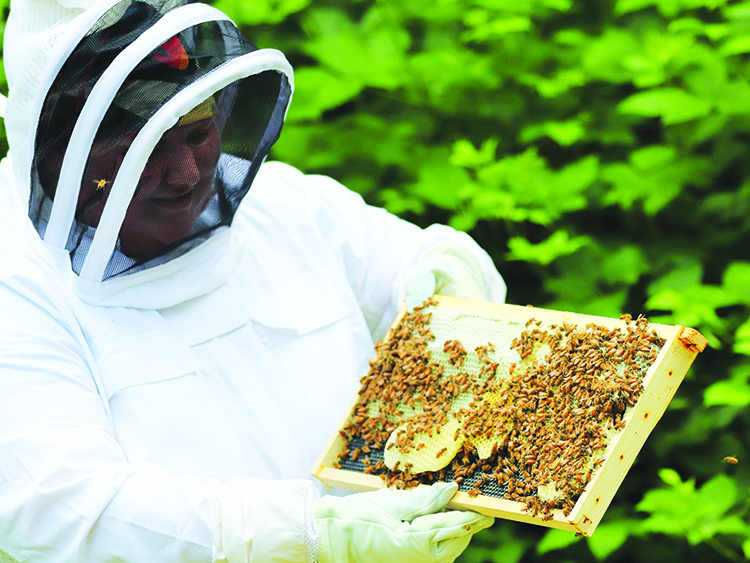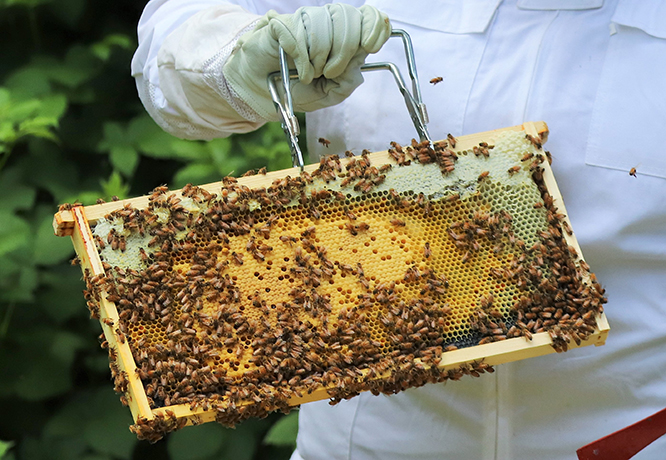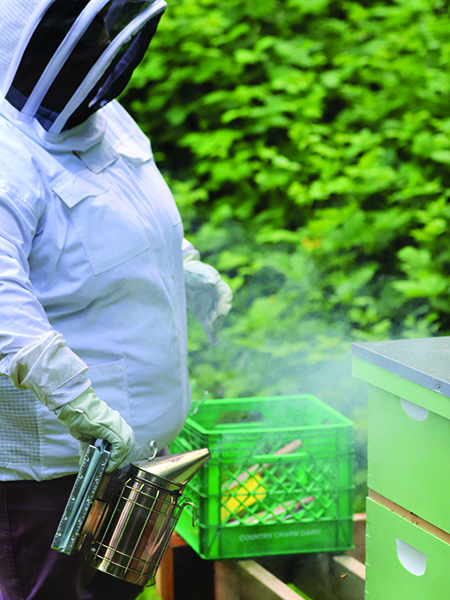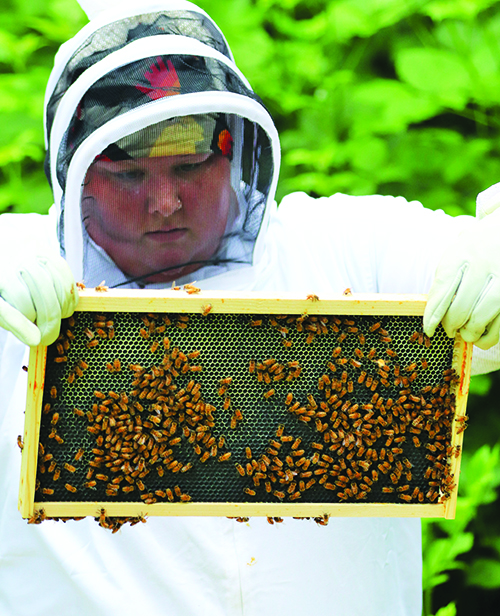
By Micheal Rios, Tulalip News
Ten years ago, Tulalip tribal member Mary Jane Topash was enjoying her undergrad experience at the University of Washington when the opportunity to view an informing documentary about bees presented itself. She quickly found herself captivated by their importance to the environment and high level of interconnectedness. The dream to someday become a beekeeper was created that day.
Fast forward seven years to Mary Jane perusing Facebook when an advertisement for a local business, Snohomish Bee Company, offering classes to become an apprentice beekeeper pops on the screen. Her interest again sparked, she clicked on the ad and followed through with the class.
“It didn’t cost that much at all, like $100 maybe, and for two days they taught me all about the lifecycle of bees, beekeeping, and honey production,” recalled Mary Jane about the apprenticeship class. “There’s a short test at the end. After passing you get officially certified as a beekeeper. The best part was getting to learn a bunch of cool facts about bees and why they’re so vital to a healthy planet.”

Cool facts like at least 30% of the world’s crops and 90% of all plants require cross-pollination to spread and thrive, and here in the United States, bees are the most important pollinators. Bees earn their reputation as busy workers by pollinating billions of plants each year, including millions of agricultural crops. Their importance cannot be understated. Small bees play a big role in one out of every three bites of food we eat. Without them, many plants we rely on for everyday nourishment would die off.
After receiving her beekeeping certification in 2017, the ambitious tribal member was eager to put her skills to use, but was forced to wait until the timing was right. She needed to accumulate the necessary supplies and have enough dedicated free time to properly nurture a start-up hive. That’s time she just didn’t have while working fulltime at Hibulb Cultural Center and balancing her school work in the pursuit of a Master’s Degree in Cultural Studies from U.W.
Enter the novel coronavirus, COVID-19, and a state-wide ‘stay home, stay healthy’ order. It may have taken a few years, but all of a sudden Mary Jane had an ample supply of free time to achieve her beekeeping dream. Plus, the Tulalip Tribes had just issued their membership a stimulus check to help cope financially in times of uncertainty. Well, uncertain for some, but not the aspiring Tulalip beekeeper. The same day that stimulus payment hit her bank account, she purchased the necessary gear and supplies to create her own colony. The most important supply? The bees, of course.
“Bees are purchased in pounds, so I bought a 3-pound box of Italian honey bees. That’s about 10,000 – 12,000 bees and one queen,” explained Mary Jane. She started her own bee hive on April 29th. “In the beginning stage they are completely reliant on me to provide them with food, which is sugar water. I’ve gone through a 25-pound bag of sugar in just one month. In a few more weeks they’ll be self-reliant and won’t need me to feed them. Until then they are my bee babies.”

That previous spark of interest fully aflame now as a passion project, the 30-year-old revels in the time she’s had to build a reciprocal relationship with her bee colony. From planting them their own garden with a variety of flowers to learning their behavioral patterns from dawn until dusk, Mary Jane proved she is meant to bee. So much so that she’s already looking forward to expanding her bee family next spring.
“This whole experience has been a great way to channel energy. Overcoming the natural instinct to run or swat around bees, especially an entire hive, is an intellectual challenge,” admitted Mary Jane. Overcoming those fear-induced natural reactions, like to not flinch if a bee is buzzing by her face, shows a level of understanding about the nature of benevolent bees.
“This is my way of giving back because honey bees are so important to our environment,” she continued. “From our plant life to water to honey and their own hive, how these little guys all work together for a common goal is just amazing.”
The value of teamwork in a honeybee colony is a lesson humans could definitely benefit from, especially now in an age of seemingly endless polarization and incessant squabbling. One worker bee makes only about 1/8th of a teaspoon of honey in their entire life, but a thriving colony where everybody is doing their part can produce 10+ pounds of honey per year.
Speaking of the liquid gold, Mary Jane is curious as to what flavor of honey her bees will produce. They are surrounded by a cove of blackberry bushes and towering maple trees to forage nectar and pollen from, so odds are the locally sourced honey will taste of maple berry. The flavor won’t be confirmed until the fall when the honey is ready for harvest.
“It would be pretty cool to incorporate Lushootseed into the name of the honey,” said Mary Jane of using the traditional language of her Coast Salish people. “Haven’t decided how just yet, but it makes sense because everything my bees use to produce their honey is given from the Tulalip land.”

Lessons and valuable teachings offered by beekeeping is something Mary Jane looks forward to passing on. Recently, her 10-year-old niece Jada has shown an interest and joined in on the veiled activity. Overcoming a fear of being stung is already quite the accomplishment for a fledgling helper, and with more time maybe her curiosity will lead to becoming a nurturer of bees like her aunt.
Until the ‘stay home, stay healthy’ order is lifted and Mary Jane returns to the normalcy of her day job as an assistant director at Seattle’s Burke Museum, she will continue to enjoy her gifted time sitting on the porch watching her young pollinators perform their dance between surrounding flowers and blackberry bushes. She can’t help but beam with happiness witnessing her bee babies play their critical role in managing our ecosystem. Her decade old dream now fully realized.